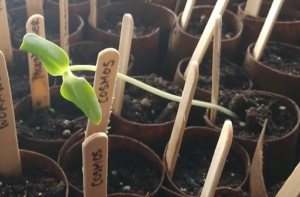See those seedlings hardening off in the header image? Those are from a garden I was growing about a decade ago. They’re strong, healthy seedlings. They’re ready to be set into the ground to thrive and grow and make veggies for us.
And then there’s this specimen:

See how it’s falling over, and it only has a single set of leaves? Those aren’t even leaves, by the by. Those are called cotyledons, or “seed leaves.” They’re just there to get the plant going. By the time a seedling is as tall as this one is, it should have several sets of leaves. So why is this poor thing falling over and not growing better and stronger?
The first thing it’s lacking is probably light. Most of the time, when we’re starting seedlings indoors, we’re short on light. There are plenty of ways to fix that, of course. You can put them on a rack with a light right above them, and put a timer on it to give them 12 hours a day. That will fix the light problem, even if they’re cheap light strips. What if you don’t have a rack with light strips, though? Well, you can make do by giving your plants as much light as you can. I have a “daylight lamp” that I use in the winter to help with depression. This time of year, I no longer need it, so I give it to my plants. I move it around, so they all share in the glory of it. Any lamp put close enough to the seedlings will help.
Your seedlings also may be too cold, or alternatively, too warm. Most seeds like to germinate between 65 and 80° F, so if your home goes below that at night (or, like mine, never gets that high even in the daytime), you may need to pick up a seed mat. The mats aren’t that expensive, and you just place your seed trays right on top of them. They keep the temperature warm but not hot, and convince your seedlings that it’s time to grow.
A third option is that you are not watering your plants enough, or that you’re over-watering them. You can tell if your plants have enough water by feeling the soil they’re in. If it’s dry and flaky, you need to water them, stat! If it’s saturated and dripping, it’s probably too wet. You need moist soil that clumps when you take a handful of it, but that isn’t dripping and sopping wet. It’s my strong opinion that the best way to water seedlings is from below. The containers your seedlings are in should have several small holes in the bottom (and if there aren’t, add some), or be made out of porous material like paper egg cartons. The containers should be sitting in a waterproof container, either one designed for the purpose or whatever you have on hand. Pour the water into the bottom of the tray, and let the soil suck it up from below. This encourages strong roots, which is important for your plant. If there’s a tiny bit of water in the tray, you’re fine. If it’s an inch deep, you need to drain it out. I also keep a mist sprayer on hand full of water, and each day I will spritz my seedlings. This helps prepare them for the rigors of a rainfall when they get outside.
The last option for helping seedlings develop strong stems and avoid them being leggy, is to blow a fan over them. This should be a VERY gentle fan, aimed above but not directly onto the seedlings. This simulates the breeze outside, which is part of what causes a plant to create thick stems and rigorous root systems. The fan, sweeping back and forth, will make your plants signal themselves to create more roots and stronger stems. Another method is to (GENTLY) brush over your seedlings with your hands each morning and evening. This need take only a couple of seconds, and should be done very carefully. You don’t want to break or damage the plants.
If you get to the point where you need to thin out seedlings (an unfortunate thing but necessary), don’t pull them up. Pulling plants disturbs the soil and surrounding plants, possibly causing more than intended to die. Instead, cut them off at the soil line. The plant will die off and feed the soil, and you can feed the thinned plants to your chickens or bunnies (so long as they aren’t poisonous).

